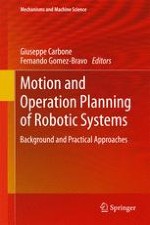
2015 | OriginalPaper | Buchkapitel
Path Planning and Trajectory Planning Algorithms: A General Overview
verfasst von : Alessandro Gasparetto, Paolo Boscariol, Albano Lanzutti, Renato Vidoni
Erschienen in: Motion and Operation Planning of Robotic Systems
Aktivieren Sie unsere intelligente Suche, um passende Fachinhalte oder Patente zu finden.
Wählen Sie Textabschnitte aus um mit Künstlicher Intelligenz passenden Patente zu finden. powered by
Markieren Sie Textabschnitte, um KI-gestützt weitere passende Inhalte zu finden. powered by
Abstract
-
roadmap techniques
-
cell decomposition algorithms
-
artificial potential methods.
-
minimum time
-
minimum energy
-
minimum jerk.